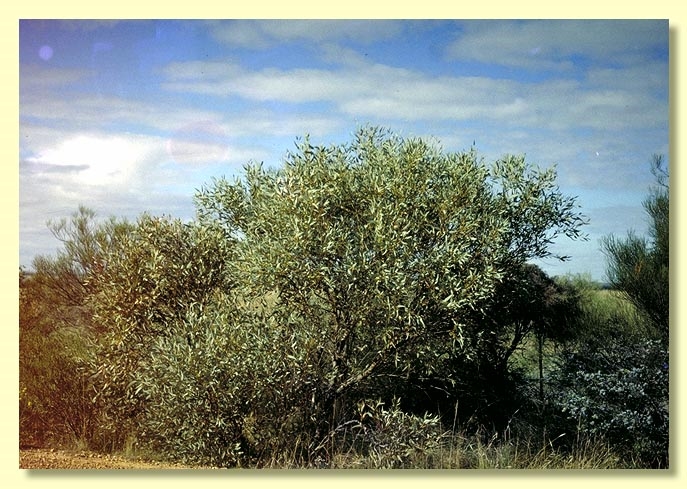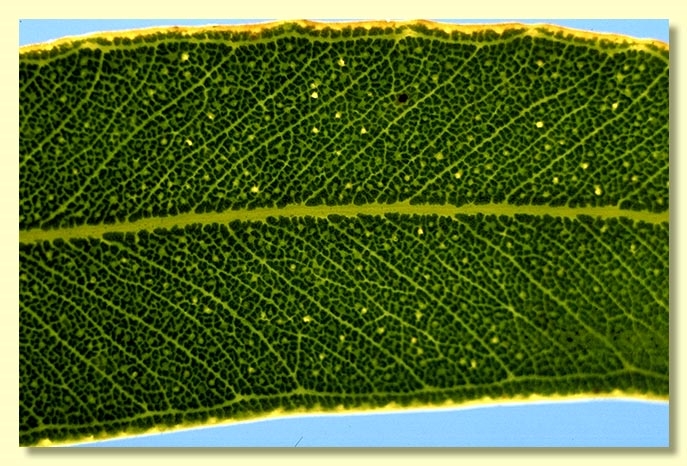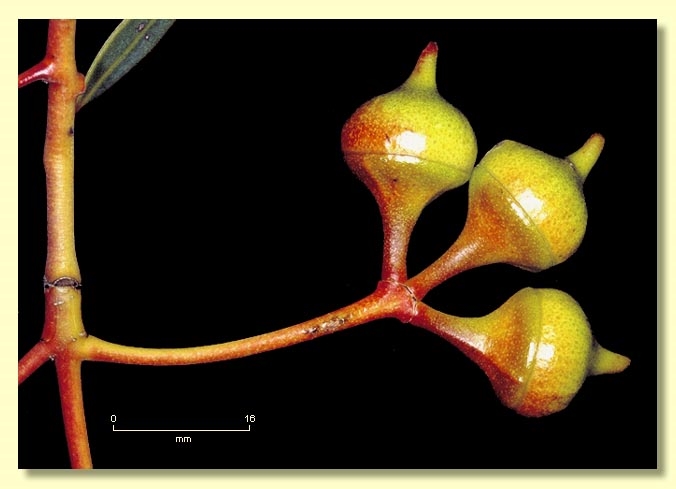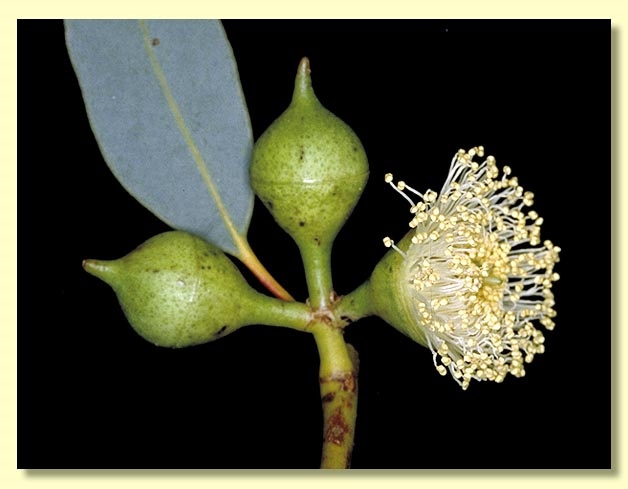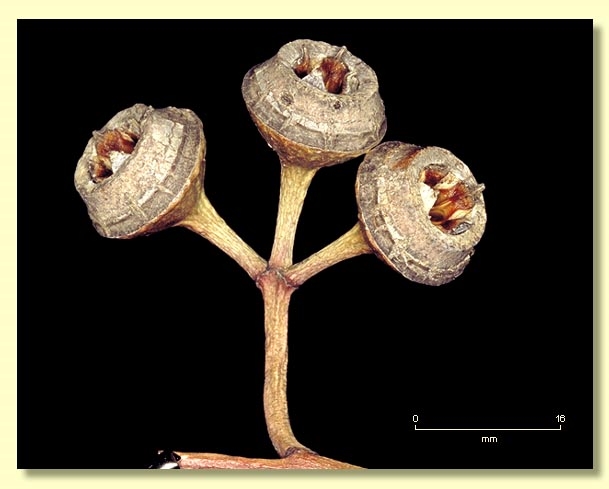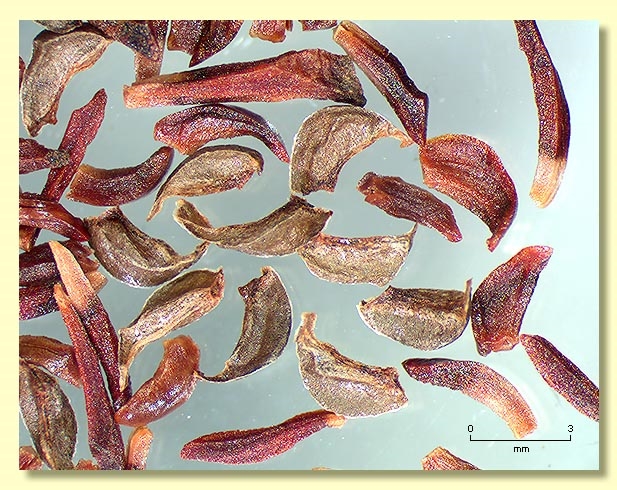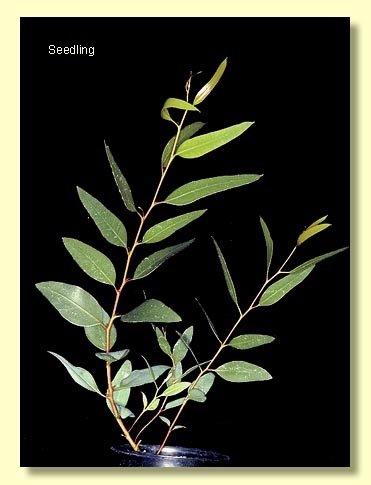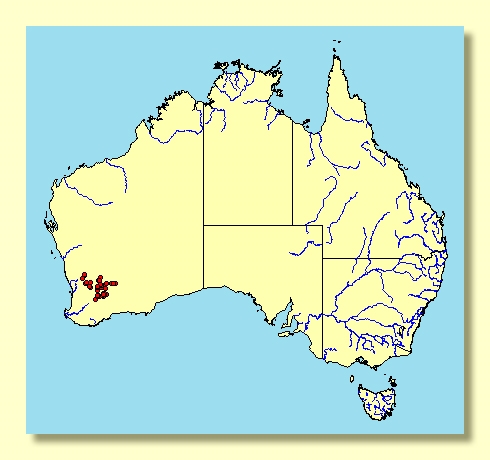Euclid - Online edition
Eucalyptus burracoppinensis
Classification
Eucalyptus | Symphyomyrtus | Bisectae | Destitutae | Curviptera | Xylocarpae
Nomenclature
Eucalyptus burracoppinensis Maiden & Blakely, J. & Proc. Roy. Soc. New South Wales 59: 178 (1925).
T: Burracoppin, W.A., 1908, J.B.Cleland s.n.; syn: NSW; Burracoppin, W.A., 2 July 1917, F.M.C.Schock s.n.; syn: MEL, NSW; halfway between Booraan siding and Burracoppin, W.A., F.M.C.Schock 205; syn: NSW, PERTH; Merredin, W.A., Jan 1924, M.Koch 3020; syn: K, NSW; Carrabin, Westonia Rd, W.A., 7 Oct. 1922, C.A.Gardner, 1852 [cited as 1825]; syn: NSW, PERTH.
T: Burracoppin, W.A., 1908, J.B.Cleland s.n.; syn: NSW; Burracoppin, W.A., 2 July 1917, F.M.C.Schock s.n.; syn: MEL, NSW; halfway between Booraan siding and Burracoppin, W.A., F.M.C.Schock 205; syn: NSW, PERTH; Merredin, W.A., Jan 1924, M.Koch 3020; syn: K, NSW; Carrabin, Westonia Rd, W.A., 7 Oct. 1922, C.A.Gardner, 1852 [cited as 1825]; syn: NSW, PERTH.
Description
Mallee to 5 m tall. Forming a lignotuber.
Bark rough on basal part of trunk consisting of persistent thin strips of grey-brown bark, smooth above grey and coppery to pink.
Branchlets lacking oil glands in the pith.
Juvenile growth (coppice or field seedlings to 50 cm): stems rounded in cross-section; juvenile leaves always petiolate, alternate, ovate to lanceolate, 7–10 cm long, 1.8–2.7 cm wide, dull, green to grey-green.
Adult leaves alternate, petioles 1–2.5 cm long; blade lanceolate, often narrowly so, 6–11.5 cm long, 0.9–2.3 cm wide, base tapering to petiole, margin entire, apex finely acute, concolorous, dull or rarely glossy, green, side-veins at an acute or wider angle to midrib, reticulation dense, intramarginal vein close to margin, oil glands sparse, intersectional.
Inflorescence axillary unbranched, peduncles 0.7–3 cm long, buds 3 per umbel, pedicels 0.3–1 cm long. Mature buds globular to squatly obovoid (1.6–3 cm long, 1.3–2 cm wide), ca 15–20 shallow longitudinal ribs sometimes present, scar present, operculum rounded and apiculate to prominently beaked (1.1–2.3 cm long), stamens oblique to inflexed, anthers cuboid, versatile, basifixed, dehiscing by longitudinal slits, style long and straight, stigma more or less blunt, locules 4(5), the placentae each with 4 vertical rows of ovules arranged with a central gap. Flowers white.
Fruit pedicellate (pedicels 0.2–1 cm long), shallowly and broadly obconical, 0.6–1.3 cm long, (1.5)1.7–2.5 cm wide, disc steeply obliquely raised and usually concave, valves 4(5).
Seeds pale brown to pale grey-brown, 2–3.5 mm long, obliquely pyramidal to more or less cuboid, always with ridges and faces, dorsal surface shallowly reticulate to smooth, a small tongue-like wing present on some seed originating low on the placenta, hilum terminal.
Cultivated seedlings (measured at node 10): cotyledons Y-shaped (bisected); stems rounded in cross-section; leaves always petiolate, opposite for 3 to 8 nodes then alternate, lanceolate, 6–10 cm long, 1.5–2.7 cm wide, green.
Bark rough on basal part of trunk consisting of persistent thin strips of grey-brown bark, smooth above grey and coppery to pink.
Branchlets lacking oil glands in the pith.
Juvenile growth (coppice or field seedlings to 50 cm): stems rounded in cross-section; juvenile leaves always petiolate, alternate, ovate to lanceolate, 7–10 cm long, 1.8–2.7 cm wide, dull, green to grey-green.
Adult leaves alternate, petioles 1–2.5 cm long; blade lanceolate, often narrowly so, 6–11.5 cm long, 0.9–2.3 cm wide, base tapering to petiole, margin entire, apex finely acute, concolorous, dull or rarely glossy, green, side-veins at an acute or wider angle to midrib, reticulation dense, intramarginal vein close to margin, oil glands sparse, intersectional.
Inflorescence axillary unbranched, peduncles 0.7–3 cm long, buds 3 per umbel, pedicels 0.3–1 cm long. Mature buds globular to squatly obovoid (1.6–3 cm long, 1.3–2 cm wide), ca 15–20 shallow longitudinal ribs sometimes present, scar present, operculum rounded and apiculate to prominently beaked (1.1–2.3 cm long), stamens oblique to inflexed, anthers cuboid, versatile, basifixed, dehiscing by longitudinal slits, style long and straight, stigma more or less blunt, locules 4(5), the placentae each with 4 vertical rows of ovules arranged with a central gap. Flowers white.
Fruit pedicellate (pedicels 0.2–1 cm long), shallowly and broadly obconical, 0.6–1.3 cm long, (1.5)1.7–2.5 cm wide, disc steeply obliquely raised and usually concave, valves 4(5).
Seeds pale brown to pale grey-brown, 2–3.5 mm long, obliquely pyramidal to more or less cuboid, always with ridges and faces, dorsal surface shallowly reticulate to smooth, a small tongue-like wing present on some seed originating low on the placenta, hilum terminal.
Cultivated seedlings (measured at node 10): cotyledons Y-shaped (bisected); stems rounded in cross-section; leaves always petiolate, opposite for 3 to 8 nodes then alternate, lanceolate, 6–10 cm long, 1.5–2.7 cm wide, green.
Flowering Time
Flowering has been recorded in August, September, October and November.
Notes
A mallee endemic to Western Australia, of scattered and widespread occurrence in the central and eastern wheatbelt, from Ballidu and Bullfinch south to Kondinin and Marvel Loch, on sandplain. The lower part of the stems have loose rough bark and leaves are green and dull.
Eucalyptus burracoppinensis belongs in Eucalyptus subgenus Symphyomyrtus section Bisectae subsection Destitutae because buds have two opercula, Y-shaped cotyledons and branchlets lack oil glands in the pith. Within this subsection E. burracoppinensis belongs in series Curviptera, one of about 30 closely related species and subspecies which are further characterised by having large buds in umbels of one, three or seven, staminal filaments erect or oblique (rarely inflexed) in bud, and large fruit usually with an ascending disc and exserted valves.
E. burracoppinensis, with its beaked buds in umbels of three, large obconical fruit with steeply ascending concave disc and obliquely pyramidal seed is most closely related to and most likely to be confused with E. oldfieldii. The latter species usually has more cupular fruit with convex or oblique ascending disc, and the buds and fruit are on a much shorter peduncles, sometimes almost sessile. The natural range of E. oldfieldii extends from the central wheatbelt near Wyalkatchem to Northampton and Wanoo and well inland to Sandstone, Leinster and Warburton. Where the two species overlap east of Wongan Hills identification may be difficult in this area.
Eucalyptus burracoppinensis belongs in Eucalyptus subgenus Symphyomyrtus section Bisectae subsection Destitutae because buds have two opercula, Y-shaped cotyledons and branchlets lack oil glands in the pith. Within this subsection E. burracoppinensis belongs in series Curviptera, one of about 30 closely related species and subspecies which are further characterised by having large buds in umbels of one, three or seven, staminal filaments erect or oblique (rarely inflexed) in bud, and large fruit usually with an ascending disc and exserted valves.
E. burracoppinensis, with its beaked buds in umbels of three, large obconical fruit with steeply ascending concave disc and obliquely pyramidal seed is most closely related to and most likely to be confused with E. oldfieldii. The latter species usually has more cupular fruit with convex or oblique ascending disc, and the buds and fruit are on a much shorter peduncles, sometimes almost sessile. The natural range of E. oldfieldii extends from the central wheatbelt near Wyalkatchem to Northampton and Wanoo and well inland to Sandstone, Leinster and Warburton. Where the two species overlap east of Wongan Hills identification may be difficult in this area.
Origin of Name
Eucalyptus burracoppinensis: from the town of Burracoppin, hence a locality name.
Copyright © CANBR 2020, all rights reserved.

Web edition hosted at https://apps.lucidcentral.org/euclid
